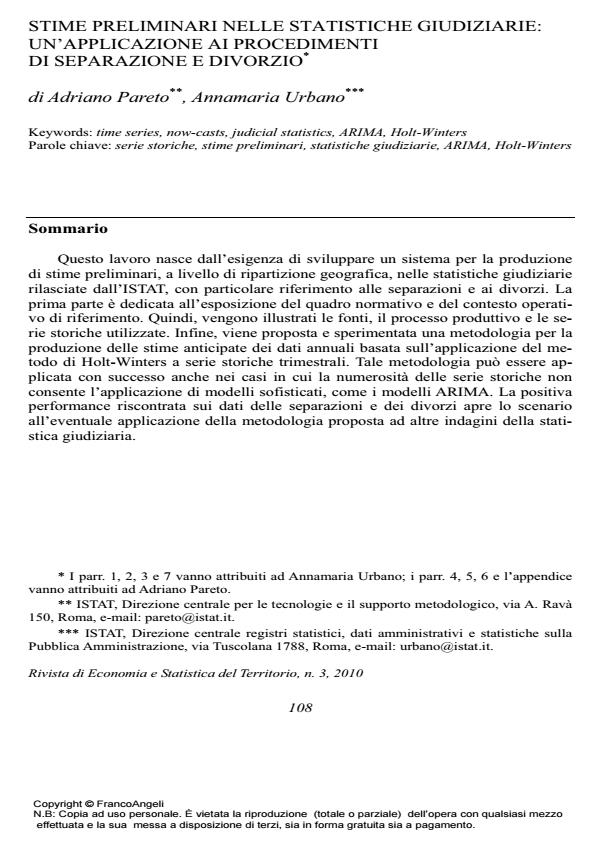Now-casts in the Judicial Statistics: an Application to Separations and Divorces Objectives
Journal title RIVISTA DI ECONOMIA E STATISTICA DEL TERRITORIO
Author/s Adriano Pareto, Annamaria Urbano
Publishing Year 2010 Issue 2010/3
Language Italian Pages 28 P. 108-135 File size 877 KB
DOI 10.3280/REST2010-003005
DOI is like a bar code for intellectual property: to have more infomation
click here
Below, you can see the article first page
If you want to buy this article in PDF format, you can do it, following the instructions to buy download credits

FrancoAngeli is member of Publishers International Linking Association, Inc (PILA), a not-for-profit association which run the CrossRef service enabling links to and from online scholarly content.
The aim of this work is to provide a tool for making now-casts by geographical area in the Judicial Statistics produced by the Italian National Statistical Institute (ISTAT) concerning separations and divorces. Now-casts are short-run forecasts that provide preliminary estimates of variables of interest for the current year. Data consists of quarterly figures and now-casts are based on the forecasts for the fourth quarter. Methods and Results Methods that can be used for making now-casts range from very simple extrapolation procedures to sophisticated stochastic time-series models. The proposed tool in this study is based on the Holt-Winters method. It is among the most widely known and used forecasting techniques in industry and business for seasonal time series and its popularity is due to simple model formulation and good forecasting results. Four models were tested and an alternative method for dependent data - ratio method - was introduced to improve the forecast accuracy. Ratio method performs better, on average, than classic method (the average absolute percentage error of now-cast is equal to 1.16%). Forecast errors for Centre and South are in general larger than those for the other areas, because of some anomalies in time series connected to the different working context and organization of judicial offices. Conclusions The proposed methodology allows to improve data coverage and reduce enough time dissemination of data. The good results obtained are pushing to apply the method to other statistical surveys on justice, after changes necessary to forecast the new variables’ figures.
Jel codes: C22, C53
Adriano Pareto, Annamaria Urbano, Stime preliminari nelle statistiche giudiziarie: un'applicazione ai procedimenti di separazione e divorzio in "RIVISTA DI ECONOMIA E STATISTICA DEL TERRITORIO" 3/2010, pp 108-135, DOI: 10.3280/REST2010-003005